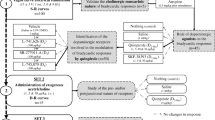Summary
The antimuscarinic activity of mianserin and amitriptyline was investigated in the cat superior cervical ganglion using McN-A-343 as a muscarinic agonist. Mianserin was found to have a similar order of potency to amitriptyline in this preparation, in contrast to the marked difference in their antimuscarinic activities on non-neuronal muscarinic receptors.
These findings suggest that the action of mianserin on neuronal muscarinic receptors is more important than that predicted from studies on non-neuronal receptors and may be related to its anti-depressant activity.
Similar content being viewed by others
References
Brogden RN, Heel RC, Speight TM, Avery GS (1978) Mianserin: A review of its pharmacological properties and therapeutic efficacy in depressive illness. Drugs 16:273–301
Brown DA, Caulfield MP (1979) Hyperpolarizing 'α'-adrenoceptors in rat sympathetic ganglia. Br J Pharmacol 68:435–445
Browne RG (1979) Effects of antidepressants and anticholinergics in a mouse “behavioural despair” test. Eur J Pharmacol 58:331–334
Cairncross KD, McCulloch MW, Story DF, Trinker F (1967) Modification of synaptic transmission in the superior cervical ganglion by epinephrine, norepinephrine and nortriptyline. Int J Neuropharmacol 6:293–300
Cavero I, Lefevre-Borg F, Roach AG (1980) Comparison of mianserin with desipramine and maprotiline on blood pressure responses to acetylcholine, histamine and 5-hydroxytryptamine in normotensive rats. Br J Pharmac 69:342P-343P
Chen G, Portman R, Wickel A (1951) Pharmacology of 1,1-dimethyl-4-phenyl-piperazinium iodide, a ganglion stimulating agent. J Pharmacol Exp Ther 103:330–336
De Groat WC, Volle RL (1963) Ganglionic actions of oxotremorine. Life Sci 2:618–623
De Groat WC, Volle RL (1966) The actions of catecholamines on transmission in cat superior cervical ganglion. J Pharmacol Exp Ther 154:1–13
Doggrell SA (1979) Mianserin potentiates responses to acetylcholine in the rat anococcygeus muscle. Eur J Pharmacol 55:311–314
Doxey JC, Everitt JE, Metcalf G (1978) Mianserin — An analysis of its peripheral autonomic actions. Eur J Pharmacol 51:1–10
Fisher A, Weinstock M, Gritter S, Cohen S (1976a) A new probe for heterogeneity in muscarinic receptors: 2-methyl-spiro-(1,3-dioxolane-4,3′)-quinuclidine. Eur J. Pharmacol 37:329–338
Fisher A, Grunfield Y, Weinstock M, Gritter S, Cohen S (1976b) A study of muscarinic receptor heterogeneity with weak antagonists. Eur J Pharmacol 38:131–139
Frankhuyzen AL, Bonta IL (1974) Effect of mianserin, a potent antiserotonin agent, on the isolated rat stomach fundus preparation. Eur J Pharmacol 25:40–50
Haefely W (1974) The effects of 5-hydroxytryptamine and some related compounds on the cat superior cervical ganglion in situ. Naunyn-Schmiedeberg's Arch Pharmacol 281:145–165
Janowsky DS, Davis JM, El-Yousef MK, Sekerke HJ (1972) A cholinergic-adrenergic hypothesis of mania and depression. Lancet 2:632–635
Jaramillo J, Volle RL (1967) Nonmuscarinic stimulation and block of a sympathetic ganglion by 4-(m-chlorophenylcarbamoyloxy)-2-butynyltrimethylammonium chloride (McN-A-343). J Pharmacol Exp Ther 157:337–345
Jones A (1963) Ganglionic actions of muscarinic substances. J Pharmacol Exp Ther 141:195–205
Kadzielawa K, Giawecka I, Kadzielawa R (1968) The potentiating influence of imipramine on ganglionic effects of catecholamines. Int J Neuropharmacol 7:517–521
Kopera H (1978) Anticholinergic and blood pressure effects of mianserin, amitriptyline and placebo. Br J Clin Pharmacol 5:29S-35S
Murayama S, Unna KR (1963) Stimulant action of 4-(m-chlorophenylcarbamoyloxy)-2-butynyltrimethylammonium chloride (McN-A-343) on sympathetic ganglia. J Pharmacol Exp Ther 140:183–192
Pinder RM, Brogden RN, Speight TM, Avery GS (1973) Viloxazine: A review of its pharmacological properties and therapeutic efficacy in depressive illness. Drugs 13:401–421
Porsolt RD, Anton G, Blavet N, Jalfre M (1978) Behavioural despair in rats: a new model sensitive to antidepressant treatments. Eur J Pharmacol 47:379–391
Puech AJ, Frances H, Souto M, Chermat R, Simon P (1979) Problems of pharmacological screening for antidepressants. In: Dumont C (ed) Advances in pharmacology and therapeutics. Proc 7th Int Congress of Pharmacol, Paris 1978, vol 5. Neuropsychopharmacol Pergamon Press, Oxford p 171
Randrup A, Braestrup C (1977) Uptake inhibition of biogenic amines by newer antidepressant drugs: Relevance to the dopamine hypothesis of depression. Psychopharmacology 53:309–314
Robson RD, Antonaccio MJ, Saelens JK, Liebman J (1978) Antagonism by mianserin and classical α-adrenoceptor blocking drugs of some cardiovascular and behavioural effects of clonidine. Eur J Pharmacol 47:431–442
Saxena PR, van Houwelingen P, Bonta IL (1971) The effects of mianserin hydrochloride on the vascular responses evoked by 5-hydroxytryptamine and related vasoactive substances. Eur J Pharmacol 13:295–305
Smith JC (1966) Pharmacologic interactions with 4-(m-chlorophenylcarbamoyloxy)-2-butynyltrimethylammonium chloride, a sympathetic ganglion stimulant. J Pharmacol Exp Ther 153:276–284
Takeshige C, Volle RL (1964) Similarities in the ganglionic actions of calcium ions and atropine. J Pharmacol Exp Ther 145:173–180
Vargaftig BB, Coignet JL, de Vos CJ, Grijsen H, Bonta IL (1971) Mianserin hydrochloride: peripheral and central effects in relation to antagonism against 5-hydroxytryptamine and tryptamine. Eur J Pharmacol 16:336–346
Wallis DI (1979) The apparent multiplicity of ganglionic receptors. In: Kalsner S (ed) Trends in autonomic pharmacology, vol 1, Urban & Schwarzenberg, Inc., Baltimore Munich, p 21
Wamsley JK, Black AC Jr, Redick JA, West JR, Williams TH (1978) SIF cells, cyclic AMP responses and catecholamines of the guinea pig superior cervical ganglion. Brain Res 156:75–82
Weinstock M, Cohen D (1976) Tricyclic antidepressant drugs as antagonists of muscarinic receptors in sympathetic ganglia. Eur J Pharmacol 40:321–328
Author information
Authors and Affiliations
Rights and permissions
About this article
Cite this article
Kwok, Y.H., Mitchelson, F. Comparison of the antimuscarinic activity of mianserin and amitriptyline in the cat superior cervical ganglion. Naunyn-Schmiedeberg's Arch. Pharmacol. 316, 161–164 (1981). https://doi.org/10.1007/BF00505311
Received:
Accepted:
Issue Date:
DOI: https://doi.org/10.1007/BF00505311



